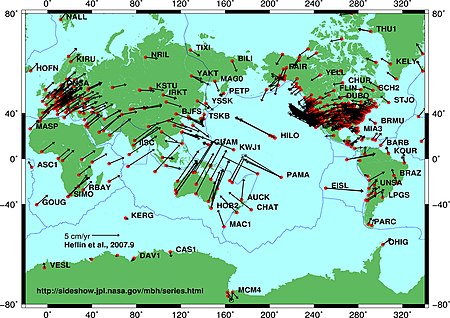
What's inside the earth? In the early part of the 20th century, geologists studied the vibrations (seismic waves) generated by earthquakes to learn more about the structure of the earth's interior. They discovered that it is made up of these distinct layers: the crust, the mantle, and the core.
An earthquake (also known as a quake, tremor or temblor) is the perceptible shaking of the surface of the Earth, which can be violent enough to destroy major buildings and kill thousands of people. The severity of the shaking can range from barely felt to violent enough to toss people around. Earthquakes have destroyed whole cities. They result from the sudden release of energy in the Earth's crust that creates seismic waves. The seismicity, seismism or seismic activity of an area refers to the frequency, type and size of earthquakes experienced over a period of time.
Earthquakes are measured using observations from seismometers. The moment magnitude is the most common scale on which earthquakes larger than approximately 5 are reported for the entire globe. The more numerous earthquakes smaller than magnitude 5 reported by national seismological observatories are measured mostly on the local magnitude scale, also referred to as the Richter magnitude scale. These two scales are numerically similar over their range of validity. Magnitude 3 or lower earthquakes are mostly almost imperceptible or weak and magnitude 7 and over potentially cause serious damage over larger areas, depending on their depth. The largest earthquakes in historic times have been of magnitude slightly over 9, although there is no limit to the possible magnitude. The most recent large earthquake of magnitude 9.0 or larger was a 9.0 magnitude earthquake in Japan in 2011 (as of March 2014), and it was the largest Japanese earthquake since records began. Intensity of shaking is measured on the modified Mercalli scale. The shallower an earthquake, the more damage to structures it causes, all else being equal.
At the Earth's surface, earthquakes manifest themselves by shaking and sometimes displacement of the ground. When the epicenter of a large earthquake is located offshore, the seabed may be displaced sufficiently to cause a tsunami. Earthquakes can also trigger landslides, and occasionally volcanic activity.
In its most general sense, the word earthquake is used to describe any seismic event — whether natural or caused by humans — that generates seismic waves. Earthquakes are caused mostly by rupture of geological faults, but also by other events such as volcanic activity, landslides, mine blasts, and nuclear tests. An earthquake's point of initial rupture is called its focus or hypocenter. The epicenter is the point at ground level directly above the hypocenter.
The earth ejects lava, rock fragments, hot vapor and gases during volcanic eruptions. Volcanoes vary based on size, shape, composition and eruptive style. Learn about the different types of volcanoes, such as shield, cinder cone and composite cone.
Volcanoes
Volcanoes are a good way for the earth to blow off a little steam. More correctly, volcanoes are vents in the earth's crust through which lava, rock fragments, hot vapor and gases are ejected. And while they are all natural events in the life of earth, there are different types of volcanoes. The types of volcanoes are differentiated based on their size, composition and explosive style.
In fact, we could compare the different types of volcanoes to players on a football team. The tall and impressive composite cone volcanoes are much like the strong and confident quarterback. The broad and lower-to-the-ground shield volcanoes are much like the beefy lineman of the team. And the fast-growing but smaller cinder cone volcanoes are much like the quick-moving and compactly built running backs of our team. Let's take a closer look at these three main types of volcanoes.
Composite Cone Volcanoes
Composite cone volcanoes, which are also called 'stratovolcanoes' or simply 'composite volcanoes,' are cone-shaped volcanoes composed of layers of lava, ash and rock debris. Composite cone volcanoes are grand sites and can grow to heights of 8,000 feet or more. Mount St. Helens and Mount Rainier, which are both found in Washington State, are impressive examples of composite volcanoes.
These steep-sided volcanoes erupt in an explosive manner. In fact, Mount Vesuvius is a composite volcano that is most famous for burying the ancient Roman city of Pompeii in up to 20 feet of volcanic ash in 79 AD. The explosiveness of their eruptions is due to the thick, highly viscous lava that is produced by composite cone volcanoes.
And this viscous lava has a lot to do with why they are shaped the way they are. The thick lava cannot travel far down the slope of the volcano before it cools. This makes the sides of the composite volcano steep. These explosive volcanoes also spew out eruptions of small rock and ash, which gets deposited on the sides of the volcano. Therefore, we see that composite volcanoes are composed of alternating layers of hardened lava, volcanic ash and rock fragments, which is why they are called 'composite.'
Shield Volcanoes
Shield volcanoes are broad, domed-shaped volcanoes with long, gently sloped sides. If you were to fly over top of a shield volcano, it would resemble a warrior's shield, hence the name. These volcanoes can cover large areas but never grow very tall. The reason these volcanoes tend to flatten out is due to the composition of the lava that flows from them, which is very fluid. This more fluid lava spreads out in all directions but cannot pile up in steep mounds.
The
Rock Cycle chart below shows each type of rock connected by
arrows. The arrows point from one rock form to a new form that it can
become over time and exposure.
The Rock Cycle describes the process the earth uses to recycle rocks. Yes, even rocks are recycled.
There are three basic types of rocks: igneous, metamorphic, and sedimentary.
The interesting part of knowing these names is that any one of the
three types of rock can be changed into one of the other types.
The
names of the rock types refer to the way the rocks are formed. Igneous
rocks are formed from fiery molten magma. Metamorphic rocks form under
intense heat and pressure. Sedimentary rocks form by weathering.
Click on the picture if you want to learn
more about that type of rock. For details on how rocks change from one
form to another,
click on the arrow. You’ll read about how rocks can
change from one form to another.
Let’s take a closer look at each type.
Igneous Rocks
Igneous
rocks are formed of magma, the molten form of the earth’s mantle layer.
Igneous rocks can form above ground as lava spewing from volcanoes. But
igneous rocks can also form below the surface. Pockets of magma get
stuck in layers of the earth. As they get closer and closer to the
surface, the magma slowly cools. Granite is an igneous rock that formed
from a slow-cooling pocket of magma.
Sedimentary Rocks

Sedimentary
rocks form from small weathered particles of other rocks or the
weathered shells of sea animals. Wind and rain beating on the faces of
exposed rock tend to wear off particles that are blown or washed to a
new location. When sea creatures die, the shells settle on the bottom of
the ocean. As the sediments pile up, they press together to form
Sedimentary rock.
Metamorphic Rocks
Metamorphic Rocks
form under intense heat and pressure. Metamorphic rocks start out as
igneous rocks, sedimentary rocks or other types of metamorphic rocks,
but through heat or pressure, change characteristics such as sheen,
tightness of grain and hardness.
Rocks continually change form.
What started out as sedimentary rock may change to metamorphic and, with
time and weathering, change back to sedimentary.
Science G6, First Quarter, First Semester on September 2015
















































